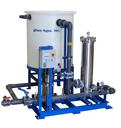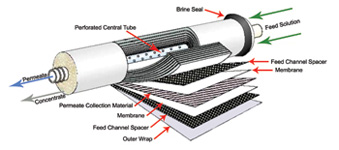Cleaning Skid Series
The cleaning skid is designed for manual
operation through a local control box located on
the skid. A chemical storage tank is mounted on
its own stand and connected to the skid with
either hard PVC piping or quick disconnect
fittings and flexible hoses. This gives the unit
the ability to be mounted in a permanent
location or totally portable if desired. The
piping is schedule 80 PVC that is
hydrostatically tested at the factory. The
electrical enclosure is NEMA 4X. All skid wiring
is completed and tested before shipment.
Standard Features
Skid mounted unit
Chemical solution tank with cover
PVC piping
316L Stainless cleaning pump
5 micron cartridge filter with stainless
steel housing (CS8) or polypropylene
(CS4)
Local flow meter
Tank level switch (CS 8)
220V/1Ph/60Hz or 460V/3Ph/60Hz |
Available
Options
220V/1Ph/50Hz or 380-415V 3Ph 50Hz
pH Controller
Electric heater for chemical tank with
temperature controller
Flexible hoses for cleaning connection
Wheel mounted skids for smaller units
Mixer
Applications
Membrane cleaning
Descaling |

Membrane Cleaning
Chemicals
Acid and alkaline cleaning chemicals are most
commonly used for membrane cleaning. Acid
cleaners are designed to remove inorganic and
iron deposits. Acid cleaning should be performed
at a pH of about 2. Alkaline cleaners are
designed for removal of biological matter,
organic foulants, and silica deposits. Alkaline
cleaning is performed at a pH of about 12.
|
Model No. |
Number of pressure vessels to be
cleaned at a time |
Pipe Material |
Pipe Size |
Tank Capacity |
Shipping Weight |
|
CS4-1 |
1 (4") |
Schedule 80 PVC |
1" |
50 |
300 |
|
CS4-2 |
2 (4") |
Schedule 80 PVC |
1" |
100 |
350 |
|
CS4-3 |
3 (4") |
Schedule 80 PVC |
1" |
150 |
375 |
|
CS8-1 |
1 (8") |
Schedule 80 PVC |
1.5" |
150 |
500 |
|
CS8-2 |
2 (8") |
Schedule 80 PVC |
1.5" |
200 |
600 |
|
CS8-3 |
3 (8") |
Schedule 80 PVC |
2" |
300 |
700 |
|
CS8-4 |
4 (8") |
Schedule 80 PVC |
2" |
360 |
800 |
|
CS8-5 |
5 (8") |
Schedule 80 PVC |
2" |
500 |
900 |
|
CS8-6 |
6 (8") |
Schedule 80 PVC |
3" |
625 |
980 |
Membrane Cleaning
Process
Reverse Osmosis membrane elements can experience
a decline in performance due to the accumulation
of deposits on the membrane surface. Mineral
scale, colloidal particles, biological matter,
and insoluble organic compounds are the usual
causes of membrane fouling. When production of a
Reverse Osmosis system drops by at least 10
percent, or the differential pressure increases
by 15 percent (over normal operating
conditions), membrane cleaning should be
performed. The following is a summary of the
design of CWG, Inc. cleaning stations and
cleaning chemicals. More details instructions
are available in the Operating and Maintenance
manual for the CWG, Inc. Cleaning
Stations.

The illustration
above represents a simplified spiral-wound
membrane element
|